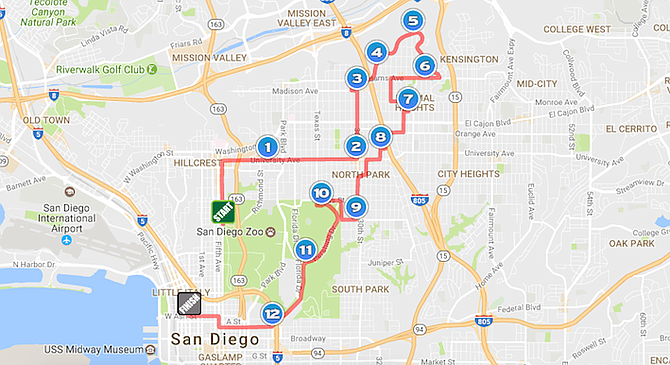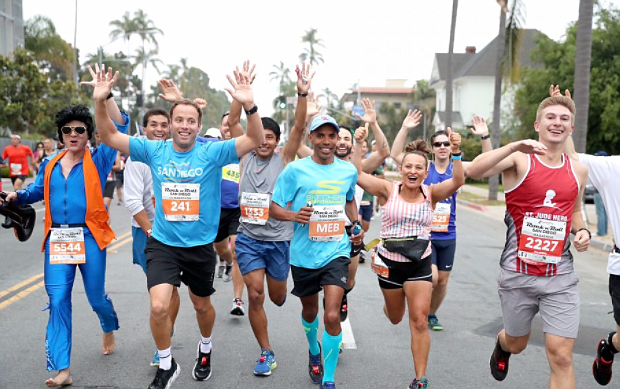 Facebook
Facebook
 X
X
 Instagram
Instagram
 TikTok
TikTok
 Youtube
Youtube

“I didn’t miss church [because] I’m the choir director – so it’s essential that I get there,” said Nina Gilbert.

Gilbert was one of the prepared ones for the detours and roadblocks brought about by the Rock ‘N’ Roll Marathon on Sunday (June 4).
The Cardenas family from City Heights was not as prepared; they missed Mass that Sunday at 10:00 a.m. in Normal Heights. “I didn’t get to see my friends that day,” said the daughter. Her friends did not make it either.
Before the marathon, Gilbert inquired with her North Park neighbors on the potential routes around the roadblocks. Meryl was quick to respond “I work for RNR (Rock ‘N’ Roll) [Marathon]; head to our website … we have access points all over, and we work closely with Waze. They know our closures and can route you around.”
Waze is an app that helps drivers by sharing traffic information inputted by the other drivers on the road in the vicinity. It also gives others advance intel on accidents, road conditions, hazards and police traps on the nearby streets.
Calvary Chapel Point Loma posted about the app a day prior to the marathon.
“I could get east on El Cajon Boulevard, but not onto the northbound 805 on ramp,” Gilbert said, “I had to go south, then [I] kept encountering more barricades and having to turn the opposite way from what my GPS was telling me to do. [I] eventually managed to loop back to the University Avenue entrance to the 805.”
The Cardenas family said that they were stuck in a standstill coming into Normal Heights and had to turn around when they realized that Mass was almost over. They said that the electronic devices didn’t change the situation if traffic was blocked anyways.
“That was the worst ever [and] the most unorganized road closure ever,” said a Normal Heights resident on the Nextdoor app, “I have a bad hip and had to walk 25 minutes to try and catch a ride to church.”
A neighbor posted on the Facebook app, “sorry, I couldn’t get to any open street from the house to the church, all because of this marathon.”
Many of the churches near the marathon-route posted warnings of traffic delays and blockages on Facebook. They posted hyperlinks to the marathon map and other solutions for church-goers. Soul Church in Little Italy posted signs on the re-routed streets that would lead to their State Street location. Mission Hills United Church of Christ postponed their worship one hour later to 11 a.m. The Resolved Church moved their ceremony from the morning to 5 p.m., because the marathon was “prohibiting access to our building.”
A member of the St. Joseph’s Cathedral forewarned her fellow parishioners “don’t forget [the] street closures tomorrow … maybe we should all jog to church.” Another member was running a little late, but said the church waited and “I was able to fulfill my service and proclaim not just my reading, but another reading because (I assumed) that lector was also delayed by traffic.”
If churchgoers weren’t aware of the many online traffic warnings, pamphlets were distributed to some of the households.
“Again, I never received a pamphlet or any closure warning,” posted one North Park resident, “this is not an event for a residential neighborhood (30,000 people)!!! Let’s have them do it in La Jolla next year and see how they like it [and] they can run up and down Soledad Mountain and really get some exercise and the scenery is better.”
That day, Gilbert made it on time to the Congregational Church of La Jolla; the deacon did not. “My only issue was with communication,” she said, “I was given lots of confident, authoritative instruction; and it didn’t work. The websites contradicted each other. There was also signage posted in advance that was removed a few days before the event and the phone line never returned my call, though the machine said they would.”
The Cardenas family did not get a pamphlet either and said they have no negative feelings towards the marathon.
Many didn’t attend church this Sunday because they participated in the marathon themselves. Some marathon-teams represented their San Diego churches.


“I didn’t miss church [because] I’m the choir director – so it’s essential that I get there,” said Nina Gilbert.

Gilbert was one of the prepared ones for the detours and roadblocks brought about by the Rock ‘N’ Roll Marathon on Sunday (June 4).
The Cardenas family from City Heights was not as prepared; they missed Mass that Sunday at 10:00 a.m. in Normal Heights. “I didn’t get to see my friends that day,” said the daughter. Her friends did not make it either.
Before the marathon, Gilbert inquired with her North Park neighbors on the potential routes around the roadblocks. Meryl was quick to respond “I work for RNR (Rock ‘N’ Roll) [Marathon]; head to our website … we have access points all over, and we work closely with Waze. They know our closures and can route you around.”
Waze is an app that helps drivers by sharing traffic information inputted by the other drivers on the road in the vicinity. It also gives others advance intel on accidents, road conditions, hazards and police traps on the nearby streets.
Calvary Chapel Point Loma posted about the app a day prior to the marathon.
“I could get east on El Cajon Boulevard, but not onto the northbound 805 on ramp,” Gilbert said, “I had to go south, then [I] kept encountering more barricades and having to turn the opposite way from what my GPS was telling me to do. [I] eventually managed to loop back to the University Avenue entrance to the 805.”
The Cardenas family said that they were stuck in a standstill coming into Normal Heights and had to turn around when they realized that Mass was almost over. They said that the electronic devices didn’t change the situation if traffic was blocked anyways.
“That was the worst ever [and] the most unorganized road closure ever,” said a Normal Heights resident on the Nextdoor app, “I have a bad hip and had to walk 25 minutes to try and catch a ride to church.”
A neighbor posted on the Facebook app, “sorry, I couldn’t get to any open street from the house to the church, all because of this marathon.”
Many of the churches near the marathon-route posted warnings of traffic delays and blockages on Facebook. They posted hyperlinks to the marathon map and other solutions for church-goers. Soul Church in Little Italy posted signs on the re-routed streets that would lead to their State Street location. Mission Hills United Church of Christ postponed their worship one hour later to 11 a.m. The Resolved Church moved their ceremony from the morning to 5 p.m., because the marathon was “prohibiting access to our building.”
A member of the St. Joseph’s Cathedral forewarned her fellow parishioners “don’t forget [the] street closures tomorrow … maybe we should all jog to church.” Another member was running a little late, but said the church waited and “I was able to fulfill my service and proclaim not just my reading, but another reading because (I assumed) that lector was also delayed by traffic.”
If churchgoers weren’t aware of the many online traffic warnings, pamphlets were distributed to some of the households.
“Again, I never received a pamphlet or any closure warning,” posted one North Park resident, “this is not an event for a residential neighborhood (30,000 people)!!! Let’s have them do it in La Jolla next year and see how they like it [and] they can run up and down Soledad Mountain and really get some exercise and the scenery is better.”
That day, Gilbert made it on time to the Congregational Church of La Jolla; the deacon did not. “My only issue was with communication,” she said, “I was given lots of confident, authoritative instruction; and it didn’t work. The websites contradicted each other. There was also signage posted in advance that was removed a few days before the event and the phone line never returned my call, though the machine said they would.”
The Cardenas family did not get a pamphlet either and said they have no negative feelings towards the marathon.
Many didn’t attend church this Sunday because they participated in the marathon themselves. Some marathon-teams represented their San Diego churches.
Comments